
Cauterizing Procedure Page Menu: 1 2 3 4 5 6 7 8 next>>
Cauterizing Procedure During the Golden Age of Piracy, Page 7
Actual Cautery Procedure
Using
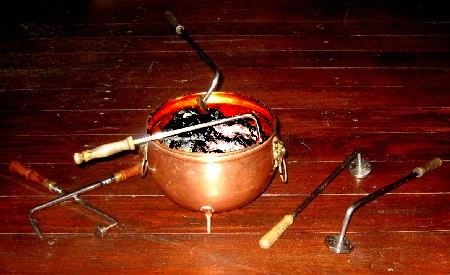
The Author's Brazier and Cautery Irons
cautery irons began by selecting the type of irons needed for the surgical procedure - what they did and how they were formed to serve their particular function. However, since the types of cautery irons and the purpose have already been discussed in the Cauterizing Tools article, we will not go into it here in detail. This page focuses instead on the procedure itself, mentioning the type of iron used, but detailing some of the considerations for cauterization, moving on to how the surgeon, his assistants, and the patient prepared for cauterization.
Although there are some generic aspects to the procedure for using red hot irons, much is tailored to the part of the body that was being cauterized and the purpose of cauterization. For example, we have already talked a little about cauterizing rotten teeth using both potential and actual cauterization. This required fine instruments and protective devices to keep the rest of the mouth safe during cauterization. We will look at the cautery procedures used in several other operations in some detail and then finish with a discussion of some post-operative procedures.
Actual Cautery Procedure: General Preparation
A number of things were required when preparing to cauterize with irons. The most
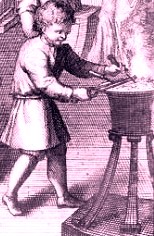
Heating Cautery Irons from
The Martyrdom of Mercury
J. Sintelaer, p.104 (1709)
obvious was to prepare a fire of red hot coals to heat the irons. This was done in a chafing dish, which is discussed here in the Cauterizing Tools article. Once the coals were hot, the irons had to be placed to make them red hot for use.
We've already mentioned the problem of heating the irons to the proper temperature when discussing the pros and cons of cauterization. As sea surgeon James Yonge explained, "if the Iron be too hot, it either brings off the Eschar [burnt scarred tissue that has sealed the wound] with it, or leaves it loose; if not hot enough, it begets nothing but pain and anguish"1. None of the period books give a great deal of detail on how to determine when an iron has reached the proper temperature. Yonge dryly suggests that the reader can but "imagine how difficult it is to heat those dreadful Instruments to the exact degree they ought: and how dangerous when it's time to use them, to delay till they are reduced to it."2
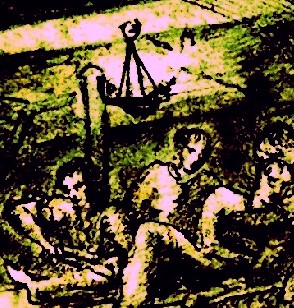
Lighting in the Cockpit, unknown artist (1820)
In addition to heating the tools, several other factors were required to prepare for cauterization. One was providing adequate light for the operation. When treating a man with cancer of the mouth, military surgeon Richard Wiseman explains how he and another surgeon "placed the Patient in a clear light" before beginning to cauterize.3 He also reveals how, when preparing to cauterize hemorrhoids, the "Patient rose out of his Bed, and placed himself towards the light, leaning upon the side of his Bed"4. (Good light would be a challenging thing to find on the Orlop deck of a ship, which is where most sea surgeons operated. This may have contributed to cauterization not being used shipboard.)
Patient position would also be important when preparing for such an operation. Position would depend a great deal on where the cautery was being applied. When Wiseman was operating on a patient's mouth, he had patient seated. In the hemorrhoid operation mentioned above, the patient was standing. He repeats this in a description of a hernia operation, although the purpose is much different. Wiseman explains that while the cautery irons were heating in the chafing dish, "the Patient must stand, and hold in his breath, by which doing the Tumour in Inguine [in the groin] will be more apparent."5 Upon finding the tumor, Wiseman "circumscribed [it] within a triangular figure: after which the Patient... [is] placed on his Back"6.
Wiseman also applied a couple of procedures designed to purge bad humors for a patient with cancerous growths that he was preparing to cauterize. He notes that while he was having cautery irons made especially for the operation, "the Patient was let bloud, purged, and prepared for the work."7
1,2 James Yonge, Currus Triumpalis, é Terebinthô., p. 14; 3 Richard Wiseman, Eight Chirurgicall Treatises, 3rd Edition, p. 115; 4 Wiseman, p. 237; 5,6 Wiseman, p. 152; 7 Wiseman, p. 113
Actual Cautery Procedure: Surgical Assistants
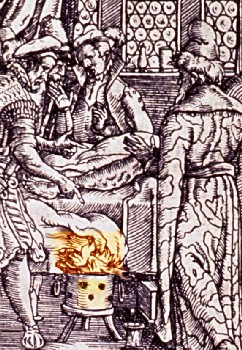
Assistants During Leg Cauterization
From Paracelsus Artzney Buch,
Plate 175 (1565)
In painful operations such as cauterization and amputation, a surgeon required assistants to be on hand to hold the patient down for the procedure. There were no pain killers and there is little evidence for either alcohol or opiates being given before an operation. (After the operation was a different matter entirely.)
When discussing removal of cancers from the mouth, Wiseman always seems to have an assistant on hand. For example, he explains in one such operation, "One of the Assistants held his Head and upper Lip, whilst I with a Speculum oris held down the Tongue with one hand, and with the other passed a plain Chisel-cautery just under the upper Lip..."1 In a similar operation, rather than use a mechanical speculum, he had two assistants, "one of my Servants holding her Head steady, whilst another held her lower Lip down and her Tongue on one side" as he cauterized.2
Because cauterization covers such a broad spectrum, an assistant may not be needed at all. For a hemorrhoid operation, Wiseman noted that the patient stood "without any body to hold him."3 It was up to the surgeon to determine what would be appropriate given the type of operation and intensity of pain the patient had to endure.
3 Richard Wiseman, Eight Chirurgicall Treatises, 3rd Edition, p. 113; 2 Wiseman, p. 112; 3 Wiseman, p. 237
Actual Cautery Procedure: Cautery Depth and Sound Skin Protection
Surgical writers expressed concern about how deep the surgeon should insert the cautery.
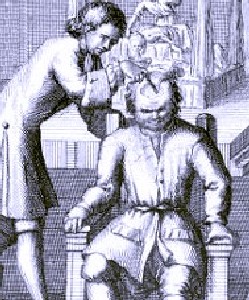
Cauterizing the Skull, from
The Martyrdom of Mercury
J. Sintelaer, p.104 (1709)
When talking about cauterizing the skull, German military surgeon Matthias Gottfried Purmann advised that when "burning with a hot Iron, remember not to press the Instrument too deep, for fear it should burn too far into the Flesh and perhaps touch the Pericranium [the periosteum or tough membrane which covers the skull] would give you a great deal of unnecessary Trouble and Vexation."1 Of course, like nearly all of the facets of cauterization, the depth of cautery iron penetration would depend a great deal on the purpose of cauterizing.
Because cauterization was so destructive, surgeons were very concerned about protecting the healthy, or sound, skin. Ambroise Paré advised when cauterizing rotten bones, "you must diligently defend the neighboring sound and fleshie part, as it were with a covering, for that the humor diffused by the touch of the fire, burn's the other places whereunto it diffuseth it self like scalding oil."2 When cauterizing rotten teeth, sea surgeon John Moyle warned "let it be done with care, that you touch not the Mouth or Gums with it. This hath [it] done with several."3
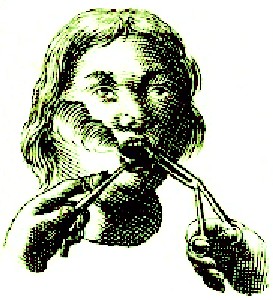
Cauterizing the Mouth Using a Speculum,
From
L'Arcenal de Chirurgie by Johannes
Scultetus,
p. 152 (1665)
The easiest, and probably least effective, way that cauterization could be performed without harming healthy flesh was by selecting the smallest cautery iron that would serve the purpose for which it was required and then making sure to deftly use that iron. Even when this was done, some sort of other protection was often used. In a case of treating mouth cancer, Wiseman had his assistant hold the patient's head firmly, thus having "his lower Lip defended, I passed in a plain Chisel cautery under the Fungus, and low as I could, to avoid scorching the Lip"4.
In another case, Wiseman used a speculum to keep the patient's tongue down, while he "passed a plain Chisel-cautery just under the upper Lip into the body of that part of the Cancer [on the roof and back of the mouth]... The carrying the Cautery thus in the middle of that cancerous lip was the way to preserve the sound parts from being scorched with the reflexion of the glowing Iron."5
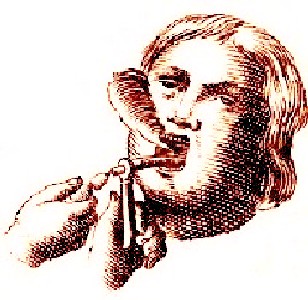
Cauterizing the Mouth Using a Cannula
From
L'Arcenal de Chirurgie by Johannes
Scultetus,
p. 152 (1665)
In other cases of mouth cancer treatment with cauteries, Wiseman explains that he had "instruments also made to defend his [the patient's] Tongue and Lips."6 Among the instruments Wiseman used in different surgeries for this purpose, he employed shields such as "a Tin-instrument [inserted] between the Tongue and the" cancerous skin he was removing.7
When cauterizing rotten bone buried deep in the skin he used "a Cannula fitted to go down through the Ulcer to the Bone: which Cannula or Pipe ought to be covered with an Emplaster or Linen starched on, and oiled, to pass in more easily."8 He added that the surgeon should have "a Bason of Water ready to cool the Pipe"9.
Surgical manuals from period and pre-period books provide examples of a surprising variety of instruments used to defend sound skin from the cautery iron. These have been covered in extensive detail on this page of the Cautery Tools article.
1 Matthias Gottfried Purmann, Churgia Curiosa, p. 22; 2 Ambroise Paré, The Workes of that Famous Chirurgion Ambrose Parey, p. 487; 3 John Moyle, The Sea Chirurgeon, p. 243; 4 Richard Wiseman, Eight Chirurgicall Treatises, 3rd Edition, p. 115; 5,6,7 Wiseman, p. 113; 8,9 Wiseman, p. 183;
Actual Cautery Procedure: Use in Amputation
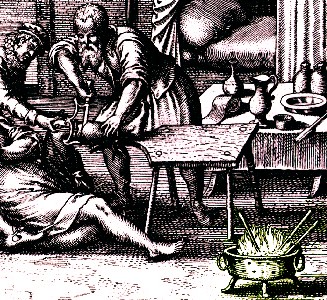
Cautery Irons being heated during an arm amputation. From the
book "De Gangrena et Sphacelo" by Willhem Hildanus (1617)
Cauterization was primarily used during amputation to stop the arteries and vessels from bleeding after the member had been sawed through. It is probably the operation for which cauteries were most used during the golden age of piracy, based on the number of authors who discuss it.
In a case from his memoirs, John Moyle provides us with a method for cauterization to stop bleeding after amputation. "I took the Cauterizing Button [iron with small button-like protrusion at the end] which was made red hot, and touched the ends of the large Arteries, to stop the bleeding, so clapt a dry Dossel of Stupa Sultilis [probably soft tow] to the end of the Bone, to defend from gleet [running fluid] and keep in the Marrow."1
Richard Wiseman adds that after "cauteriz[ing] the Artery, we do then touch the end of the Bone, it hastening the Exfoliation [casting off necrotic bone matter]. "2 Atkins warns that if the cautery irons were "not hot enough, it makes no Eschar [dead skin on the end of the bone], giving only unnecessary Anguish to the Patient: And on the other Side, if too hot, it then makes an Eschar indeed, but separates and loosens it at the same Time, the Security being intended being either way equally eluded. But this is an Inconvenience that may be obviated by a quick or slow Application, as the Surgeon shall judge to the Degree of Heat in his [cauterizing] Button."3
Paré gives some interesting comments about post-operative procedure when using cauterizing irons to scale the ends of amputated bones. He explains, "After the cauterization, you must help forwards the falling away of the [bone] scales, by sometimes dropping in our oile of whelps, being made scalding hot. This oil, though [it is] verie fit for this
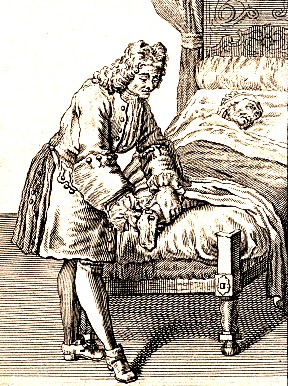
Surgeon Dressing amputated leg from Traite des
Operations de Chirurgie by Rene Garengeot, p. 407
purpose, yet I do not judge it fit to use too often, it may suffice to have dropped it in, som twice or thrice. For at length it may violate the sound bone, that lie's under the rotten, by the oilie, subtil and moist substance."4
There are some points of interest in this description, the primary one being the Oil itself. Whelps are puppies. Paré provides the recipe for this extraordinary oil in his earlier book The method of curing vvounds made by gun-shot (this quote from the 1617 English translation by sea surgeon Walter Hamond):
...two young whelpes, one pound of earth-wormes, two pounds of the oyle of Lillies, six ounces of the Terebinth of Venice, and one ounce of Aqua-vitae [brandy]: and in my presence he boiled the whelpes alive in the saide Oyle, until the flesh departed from the bones. Afterward, he tooke the wormes (having before killed and purified them in white wine, to purge themselves of the earth which they have always in their bodies) being so prepared, he boyled them also in the said Oyle till they became dry, this he strained through a Napkin, without any great expressions, that done, he added thereto the Terebinth, and lastly, the Aqua-vitae, and called God to witnesse5
The other point of interest concerns humor theory. Paré explains this further as he continues his post-operative suggestions. He notes that since "a bone is the most drie part of the bodie, therefore unctuous and moist medicines are contrarie to its temper and consistence."6 Here, we really see the humoral theory at work. Medicines were thought to have four distinct humoral properties: hot, dry, wet and cold. Many medical men believed for a medicine to be most effective, its humoral properties had to be in sympathy with the part or problem treated. Paré's concern about the oily, moist oil of whelps causing rot in the sound bones suggests that the wet heavy oil would cause the bone to rot in sympathy with the humor of the oil when they came in contact.
He gives some further thoughts on the bone scales themselves. First Paré warns that pulling the scale off "before that nature hath put a cover upon the sound bone, hee [the surgeon] shall give way to a new alteration and fowlness by the appuls[e] of the air."7 This would require beginning the healing process over. Even though he didn't believe in removing the scale at the end of the bone forcibly, "it conduceth [healing to] often and gently to moov the scales [which are] already beginning to separate themselves, and it hasten's the slackness of nature in casting them off."8
1 John Moyle, Memoirs: Of many Extraordinary Cures, p. 120; 2 Richard Wiseman, Eight Chirurgicall Treatises, 3rd Edition, p. 453; 3 John Atkins, The Navy Surgeon, p. 122 4 Ambroise Paré, The Workes of that Famous Chirurgion Ambrose Parey, p. 487; 5 Holly Tucker, quoting the 1617 English Edition of Ambroise Paré and Walter Hamond's Book, "Boiling Oil or Healing Balm?", Holly-Tucker.com, gathered 9/18/14; 6,7,85 Paré, Workes, p. 487;

